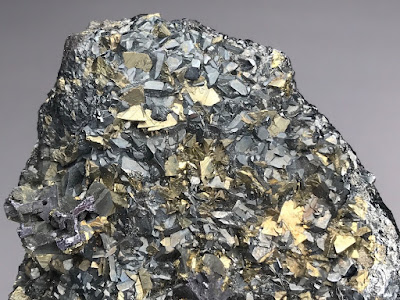硬度による四面銅鉱の鑑定 Hardness Test for Fahlore
Fluorite from Illinois, USA, waiting for the challengers. A cleaved octahedron with a ridge length to 37 mm.
加藤昭氏が執筆された「硫化鉱物読本」(関東鉱物同好会編、1999年)という冊子を行きつけの白山の店で先日入手した。硫化鉱物に関する一般的知識と主要な硫化鉱物の各論がしるされている。その「砒四面銅鉱」の項に、
「安四面銅鉱との識別は、硬度(蛍石のへき開片の間でこすると安四面銅鉱は粉末が出るが砒四面銅鉱は蛍石に傷がつく)や比重で」
おこなうことができる、とあった。蛍石はモース硬度 4 の標準物質であるのに対して、
砒四面銅鉱の硬度は 4 ~ 4½、そして安四面銅鉱のそれは 3 ~ 4
なので、たしかにかくあるべきだ。
手元に適当な蛍石のへき開片がなかったので、ふたたび白山におもむき、上の写真のような紫色の、試金石とするにはもったいないくらい立派な標本を入手。以下、実験の記録。
Akira Kato wrote in his book, which I recently obtained at a mineral and fossil shop in Hakusan, Tokyo, that comparison of hardness of fluorite (the standard mineral of the Mors scale hardness: 4) and fahlore can tell whether the fahlore is arsenic-rich tennantite (hardness: 4 ~ 4½) or antimony-rich tetrahedrite (hardness: 3 ~ 4). As I didn't have a suitable fluorite, I went to the shop again and obtained a piece of fluorite that might be too beautiful to be used for the hardness test.
1. 蛍石 vs 安四面銅鉱 Fluorite vs. Tetrahedrite
Tetrahedrite from the Casapalca mine, Peru.
これは入手時にラベルが確かだった標本。結晶の角を蛍石にこすりつけたところ…
蛍石の勝ち。
安四面銅鉱のカスが砂状にこびりつく(四面銅鉱グループはへき開がない)。蛍石にはキズがつかない。歴然とした差だった。
The winner was fluorite. Granular tetrahedrite remained on the fluorite's cleavage surface. No scratch on fluorite. There is a big difference.
2. 蛍石 vs 砒四面銅鉱 Fluorite vs. Tennantite
Tennantite from the Hanaoka mine, Odate city, Akita, Japan.
これは入手時にラベルがなかったので、鉱物種名は正直いまでも不確かである。勝負の結果は…
This specimen came to me without a label. I am not fully confident of the species.
砒四面銅鉱の勝ち。
結晶のシャープな角っこをこすりつけたら、蛍石にキズがついた。ルースな部分をこすっても勝負は判然としなかった。1 の標本よりも硬いことは感覚的にもわかった。最終確認は元素分析とかしないとダメなんだろうけど、これでこの標本が砒四面銅鉱である可能性はかなり高まったといえる。
The winner was tennantite, though the difference was not so great. It was a pity that tennantite made a scratch on fluiorite. The probability that this fahlore is arsenic rich increased, though the final conclusion cannot be made without ultimate analysis.
3. エキシビション: 蛍石 vs 黄銅鉱 Exhibition match: Fluorite vs. Chalcopyrite
黄銅鉱のモース硬度は 3½ ~ 4 なので、蛍石には負けるはず。花岡の砒四面銅鉱標本の黄銅鉱部分と勝負させると、やはり蛍石には負けた。
As chalcopyrite's hardness is 3½ ~ 4, it will be defeated by fluiorite. Experiment showed that fluorite was harder than the crystalized part of chalcopyrite in the tennantite specimen.
寸評 Comments
硬度による鉱物の識別は、初歩的ながらも意外とあっさり勝負が決まる、有効な手法であることがわかった。いろいろなモース硬度の鉱物を鑑定用に用意しておくことは有意義なことだろう。
鉱物の硬度は結晶面によって、あるいはキズをつける方向によっても異なることがある。藍晶石(カイヤナイト)はとくに硬度の異方性が大きく「二硬石」の別名がある(堀秀道「楽しい鉱物学」草思社、1999年など)。今回の蛍石による鑑定も、へき開面にこすりつける、という点がミソだろう。新鮮なへき開面はキズがなく、つねに同じ条件で硬度鑑定ができる。一般にへき開の明瞭な鉱物は、キズをつける面や方向による硬度のばらつきが大きい。
The experiment showed me that hardness test is an easy and a useful method to tell the mineral species. It will be meaningful to have various srandard minerals at hand. The hardness can be different at different crystal faces and different directions. Kyanite is the most notable example that has different hardness along different directions. In the present case it will be important to use a fresh cleaved face of fluorite because it has less defect and hardness is always the same.
From an old book by Denzo Sato ("The great mineralogy", Rokumeikan, 1925). From right to left, the hardness curves of calcite, halite, and fluorite on some crystal faces. The hardness is variable even on a cleaved surface of fluorite.







